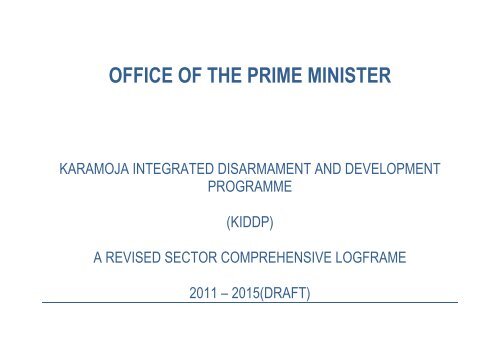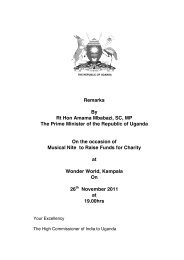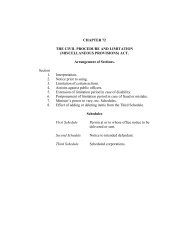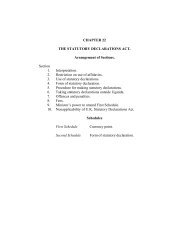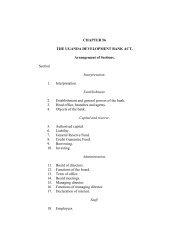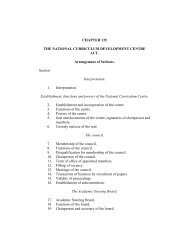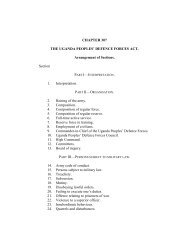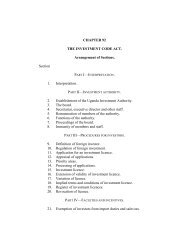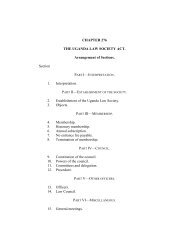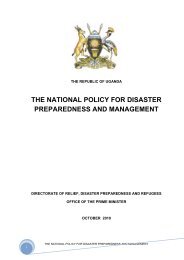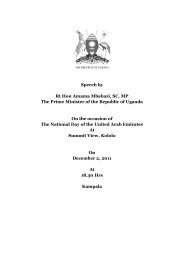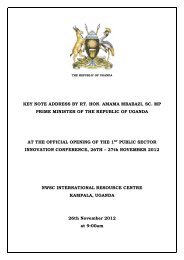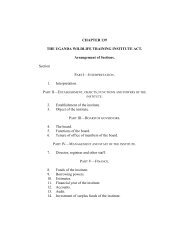Create successful ePaper yourself
Turn your PDF publications into a flip-book with our unique Google optimized e-Paper software.
OFFICE OF THE PRIME MINISTER<br />
KARAMOJA INTEGRATED DISARMAMENT AND DEVELOPMENT<br />
PROGRAMME<br />
(<strong>KIDDP</strong>)<br />
A REVISED SECTOR COMPREHENSIVE LOGFRAME<br />
2011 – 2015(DRAFT)
Acronym/Abbreviations<br />
ARDC Agricultural Research Development Center<br />
BH Borehole<br />
CSO Civil Society Organization<br />
DLG District Local Government<br />
EAC East African Community<br />
<strong>KIDDP</strong> Karamoja Integrated Disarmament and Development Programme<br />
MAAIF Ministry <strong>of</strong> Agriculture Animal Industry and Fisheries<br />
MTTI Ministry <strong>of</strong> Trade Tourism and Industry<br />
NAADS National Agricultural Advisory Services<br />
NFA National Forest Authority<br />
NGO Non Government Organization<br />
NUSAF Nor<strong>the</strong>rn Uganda Action Fund<br />
OPM <strong>Office</strong> <strong>of</strong> <strong>Prime</strong> <strong>Minister</strong><br />
UBOS Uganda Bureau <strong>of</strong> Standards
1.0 Introduction<br />
<strong>KIDDP</strong> is a medium term development framework specifically tailored to address <strong>the</strong> unique context and development challenges in Karamoja region. The<br />
overall goal <strong>of</strong> <strong>the</strong> <strong>KIDDP</strong> is “to contribute to human security and promote conditions for recovery and development in Karamoja”. <strong>KIDDP</strong> takes cognizance <strong>of</strong><br />
<strong>the</strong> National Development Plan and <strong>the</strong> Peace, Recovery and Development Programme (PRDP)<br />
The <strong>KIDDP</strong> harmonizes <strong>the</strong> various development interventions by Government, bi- lateral and multi- lateral development partners, international and national<br />
NGOs and CBOs. It <strong>the</strong>refore represents an attempt by <strong>the</strong> Government <strong>of</strong> Uganda to integrate gun collection (Disarmament) with development interventions;<br />
conflict management and peace building. Hence, using development to achieve peace.<br />
The <strong>Office</strong> <strong>of</strong> <strong>the</strong> <strong>Prime</strong> <strong>Minister</strong> is coordinating <strong>the</strong> process <strong>of</strong> revising and developing this <strong>KIDDP</strong> results matrix for a five year period 2011-2015 that would be<br />
used to track and monitor various development interventions in Karamoja region.<br />
The result matrix below gives a detailed account <strong>of</strong> intervention gaps per sector that need to be addressed and implemented over a five year period in order to<br />
achieve <strong>the</strong> overall goal.
2.0 EDUCATION SECTOR<br />
Despite <strong>the</strong> existence <strong>of</strong> <strong>the</strong> Universal Primary Education [UPE], Functional Adult Literacy (FAL) and <strong>the</strong> Universal Secondary Education [USE], Karamoja<br />
continues to record <strong>the</strong> lowest literacy levels <strong>of</strong> 12%. The above scenario is aggravated by a complexity <strong>of</strong> factors that include <strong>the</strong> traditional agro – pastoral<br />
lifestyle that requires <strong>the</strong> labour <strong>of</strong> young boys and girls as herders; high levels <strong>of</strong> poverty and negative perceptions to education by <strong>the</strong> parents. UPE and USE.<br />
Besides, <strong>the</strong>re is a high failure rate in <strong>the</strong> existing schools due to poor quality <strong>of</strong> education and this phenomenon discourages <strong>the</strong> few parents who attempt to<br />
take <strong>the</strong>ir children to school.<br />
The results matrix below identifies <strong>the</strong> existing Many parishes and sub counties in Karamoja lack both primary and secondary schools contrary to <strong>the</strong><br />
government policy <strong>of</strong> gaps in <strong>the</strong> education sector that need to be addressed so as to increase <strong>the</strong> quality and access to education in Karamoja.<br />
2.1Comprehensive results matrix for education sector in Karamoja 2011 – 2015<br />
Overall Goal: To increase <strong>the</strong> educational and literacy levels in <strong>the</strong> Karamoja sub-region<br />
<br />
Objective Activities Indicators MoV Time Frame and Target Resp.instn Estimated<br />
2011 2012 2013 2014 2015<br />
Budget<br />
Objective 1:<br />
To increase <strong>the</strong><br />
enrolment and<br />
retention <strong>of</strong> children in<br />
school<br />
Construct/ upgrade and equip<br />
40 boarding girls, and 40<br />
boarding boys’ only Primary<br />
Schools per sub county in<br />
Karamoja.<br />
0 20 20 20 20 MoE&S<br />
OPM<br />
DLGs<br />
Partners<br />
No <strong>of</strong> government<br />
aided ‘Girls Only’<br />
Boarding Primary<br />
Schools and No <strong>of</strong><br />
Boys only boarding<br />
P/Ss constructed and<br />
equipped by<br />
December 2015<br />
District and<br />
sub county<br />
records<br />
MoES EMIS<br />
District<br />
education<br />
reviews
Carry out research on <strong>the</strong><br />
various education alternatives<br />
for <strong>the</strong> Karamoja region to<br />
increase <strong>the</strong> policy argument<br />
for government supported<br />
boarding facilities taking into<br />
account <strong>the</strong> Karamojong<br />
values and livelihood<br />
3 studies carried out District and<br />
sub county<br />
records<br />
MoES EMIS<br />
District<br />
education<br />
reviews<br />
2 1 0 0 MoE&S<br />
OPM<br />
DLGs<br />
Partners<br />
Carry out an annual social<br />
mobilisation campaign<br />
targeting 200 radio talk shows<br />
and 200 community<br />
awareness meetings to<br />
sensitise communities and <strong>the</strong><br />
local and traditional leadership<br />
to take <strong>the</strong>ir children to school<br />
Establish a bursary scheme<br />
targeting 100 disadvantaged<br />
boys and girls per year<br />
Support <strong>the</strong> establishment <strong>of</strong> 2<br />
Post Primary Education and<br />
Training centre in each district<br />
Construct and re-equip 30<br />
boarding Secondary Schools<br />
in <strong>the</strong> whole <strong>of</strong> Karamoja<br />
No <strong>of</strong> radio talk<br />
shows and<br />
community<br />
sensitisation<br />
meetings held<br />
No <strong>of</strong> boys and girls<br />
receiving <strong>the</strong> bursary<br />
schemes<br />
No <strong>of</strong> PPET training<br />
centers established<br />
30 boarding<br />
secondary schools<br />
constructed and<br />
District and<br />
sub county<br />
records<br />
MoES EMIS<br />
District<br />
education<br />
reviews<br />
District and<br />
sub county<br />
records<br />
MoES EMIS<br />
District<br />
education<br />
reviews<br />
District and<br />
sub county<br />
records<br />
MoES EMIS<br />
District<br />
education<br />
reviews<br />
District and<br />
sub county<br />
records<br />
200 200 200 200 200 MoE&S<br />
OPM<br />
DLGs<br />
Partners<br />
20 20 20 20 20 MoE&S<br />
OPM<br />
DLGs<br />
Partners<br />
2 3 4 3 2 MoE&S<br />
OPM<br />
DLGs<br />
Partners<br />
10 5 10 5 MoE&S<br />
OPM<br />
DLGs
Objective II<br />
Increase retention and<br />
completion <strong>of</strong> girl child<br />
education<br />
Establish 2 appropriate<br />
technology skills development<br />
centers outside <strong>the</strong> PPET<br />
structure to cater for <strong>the</strong><br />
Karamoja youth<br />
Promotion <strong>of</strong> safe girl child<br />
friendly school environment<br />
Recruitment <strong>of</strong> 1 senior<br />
woman teacher in all Primary<br />
schools to support <strong>the</strong> girl child<br />
Provision <strong>of</strong> 500,000 locally<br />
manufactured sanitary towels<br />
for <strong>the</strong> girl child<br />
equipped<br />
No <strong>of</strong> appropriate<br />
technology skills<br />
development centers<br />
established<br />
No <strong>of</strong> child friendly<br />
schools meeting <strong>the</strong><br />
gender friendly<br />
standard with fences<br />
erected<br />
No <strong>of</strong> senior women<br />
teachers recruited<br />
and posted by<br />
districts<br />
No <strong>of</strong> girl children<br />
provided with sanitary<br />
towels<br />
MoES EMIS<br />
District<br />
education<br />
reviews<br />
District and<br />
sub county<br />
records<br />
MoES EMIS<br />
District<br />
education<br />
reviews<br />
District and<br />
sub county<br />
records<br />
MoES EMIS<br />
District<br />
education<br />
reviews<br />
District and<br />
sub county<br />
records<br />
MoES EMIS<br />
District<br />
education<br />
reviews<br />
District and<br />
sub county<br />
records<br />
MoES EMIS<br />
District<br />
education<br />
reviews<br />
100,0<br />
00<br />
Partners<br />
2 3 4 3 2 MoE&S<br />
OPM<br />
DLGs<br />
Partners<br />
100,0<br />
00<br />
100,00<br />
0<br />
100,0<br />
00<br />
100,<br />
000<br />
MoE&S<br />
OPM<br />
DLGs<br />
Partners<br />
MoE&S<br />
OPM<br />
DLGs<br />
Partners<br />
MoE&S<br />
OPM<br />
DLGs<br />
Partners
Objective III<br />
Improve <strong>the</strong> quality <strong>of</strong><br />
education in Karamoja<br />
Establish a girl child post -<br />
primary bursary scheme<br />
targeting 100 girls per district<br />
Recruit, post and retain<br />
qualified teachers in <strong>the</strong><br />
government aided primary and<br />
secondary schools in<br />
Karamoja<br />
Increase <strong>the</strong> % <strong>of</strong> hardship<br />
allowance to teachers being<br />
posted to <strong>the</strong> Karamoja region<br />
Increase <strong>the</strong> facilitation,<br />
support and number <strong>of</strong><br />
instructors in <strong>the</strong> ABEK<br />
centres<br />
Construct 2 teachers houses<br />
per school for both primary<br />
and secondary Schools per<br />
district<br />
No <strong>of</strong> girl children<br />
supported to post<br />
primary education<br />
No <strong>of</strong> districts<br />
meeting <strong>the</strong> teacher<br />
staffing ceiling<br />
% increase in <strong>the</strong><br />
hardship allowance<br />
for teachers posted in<br />
Karamoja<br />
No <strong>of</strong> ABEK<br />
instructors recruited<br />
and facilitated<br />
No <strong>of</strong> teachers<br />
houses at primary<br />
and secondary level<br />
built<br />
District and<br />
sub county<br />
records<br />
MoES EMIS<br />
District<br />
education<br />
reviews<br />
District and<br />
sub county<br />
records<br />
MoES EMIS<br />
District<br />
education<br />
reviews<br />
District and<br />
sub county<br />
records<br />
MoES EMIS<br />
District<br />
education<br />
reviews<br />
District and<br />
sub county<br />
records<br />
MoES EMIS<br />
District<br />
education<br />
reviews<br />
District and<br />
sub county<br />
records<br />
MoES EMIS<br />
District<br />
education<br />
reviews<br />
100 100 100 100 100 MoE&S<br />
OPM<br />
DLGs<br />
Partners<br />
MoE&S<br />
OPM<br />
DLGs<br />
Partners<br />
MoE&S<br />
OPM<br />
DLGs<br />
Partners<br />
MoE&S<br />
OPM<br />
DLGs<br />
Partners<br />
MoE&S<br />
OPM<br />
DLGs<br />
Partners
Support a bi-annual education<br />
conference for <strong>the</strong> Karamoja<br />
sub-region<br />
Increase supply <strong>of</strong> instructional<br />
materials to schools<br />
Establish demand side<br />
interventions targeting 2000<br />
households that will support<br />
vulnerable households to send<br />
and keep children in School<br />
(social grants, uniform support,<br />
school feeding support,<br />
scholastic material etc.)<br />
Increase support to 100 inservice<br />
training for teachers<br />
per district per annum in <strong>the</strong><br />
Karamoja region<br />
Streng<strong>the</strong>n <strong>the</strong> school<br />
inspectorate through<br />
supporting 1 vehicle, fuel, etc.<br />
No <strong>of</strong> bi-annual<br />
educational<br />
conferences held<br />
No <strong>of</strong> pupils<br />
supported with<br />
instructional materials<br />
No <strong>of</strong> households<br />
supported to send<br />
children to school<br />
No <strong>of</strong> in-service<br />
teachers supported to<br />
upgrade<br />
No <strong>of</strong> district<br />
inspectorate <strong>of</strong>fices<br />
supported with<br />
transportation and<br />
fuel<br />
District and<br />
sub county<br />
records<br />
MoES EMIS<br />
District<br />
education<br />
reviews<br />
District and<br />
sub county<br />
records<br />
MoES EMIS<br />
District<br />
education<br />
reviews<br />
District and<br />
sub county<br />
records<br />
MoES EMIS<br />
District<br />
education<br />
reviews<br />
District and<br />
sub county<br />
records<br />
MoES EMIS<br />
District<br />
education<br />
2 2 2 2 2 MoE&S<br />
OPM<br />
DLGs<br />
Partners<br />
MoE&S<br />
OPM<br />
DLGs<br />
Partners<br />
MoE&S<br />
OPM<br />
DLGs<br />
Partners<br />
MoE&S<br />
OPM<br />
DLGs<br />
Partners<br />
MoE&S<br />
OPM<br />
DLGs<br />
Partners
eviews<br />
Annual awareness creation<br />
and advocacy campaign to<br />
highlight <strong>the</strong> Karamoja region<br />
No <strong>of</strong> advocacy<br />
campaigns targeting<br />
education employees<br />
District and<br />
sub county<br />
records<br />
MoES EMIS<br />
District<br />
education<br />
reviews<br />
MoE&S<br />
OPM<br />
DLGs<br />
Partners
3.0 The Agriculture sector.<br />
3.1 Background.<br />
The Karamoja sub-region has one <strong>of</strong> <strong>the</strong> most fertile soils in Uganda but it has one rainy season, failure <strong>of</strong> which results into serious food security implications.<br />
While <strong>the</strong> sub-region receives rainfall ranging between 500mm to 700mm per annum, reducing from <strong>the</strong> wet belt in <strong>the</strong> west to <strong>the</strong> eastern zone bordering<br />
Kenya, it has experienced crop failure for <strong>the</strong> last three consecutive years.<br />
Karamoja – has experienced an increase in natural disasters, reflecting in part <strong>the</strong> impact <strong>of</strong> climate change. This has undermined <strong>the</strong> livelihoods <strong>of</strong> <strong>the</strong> agro<br />
pastoral populations in this semi-arid region. Severe droughts have decreased household crop production, while also diminishing <strong>the</strong> pasture available for<br />
livestock. Unless urgent intervention is done, <strong>the</strong>re is a danger that <strong>the</strong> process could precipitate a more intense conflict, leading to displacements and<br />
compounding any food-insecurity crises arising from natural disasters. Given <strong>the</strong> erosion <strong>of</strong> coping capacities over time, it is projected that future disasters will<br />
lead to even greater food needs.<br />
Generally, <strong>the</strong> consequences <strong>of</strong> hunger are dire. Households ration meals, sell critical livelihood assets, do odd jobs, increased unsafe sexual practices leading<br />
to higher incidences <strong>of</strong> HIV/AIDS and o<strong>the</strong>r STDs, teenage pregnancies, abortions, increased gender and <strong>the</strong>ft related violence and a drop in school<br />
attendance, ultimately having a huge negative impact on economic development. The situation is particularly critical for children. Mo<strong>the</strong>rs travel extreme<br />
distances to find meager work in exchange for some kind <strong>of</strong> food, leaving children behind who, in some cases, are fending for <strong>the</strong>mselves. Children are being<br />
pulled from or have refused to go to school due to hunger, <strong>the</strong> sick are not being treated and parents are forced to beg just for something to feed <strong>the</strong>ir children.<br />
The interventions are <strong>the</strong>refore meant to speed-up <strong>the</strong> recovery <strong>of</strong> food security in <strong>the</strong> sub-reg
3.2 Comprehensive Results Matrix for <strong>the</strong> Agricultural sector in Karamoja (KAPFS).<br />
<br />
Objectives Activities Indicators MoV Time Frame and Target Resp.<br />
2011 2012 2013 2014 2015 instn.<br />
‘000 ‘000 ‘000 ‘000 ‘000<br />
1)To increase crop<br />
production and<br />
productivity<br />
1.1 Mobilize <strong>the</strong><br />
community (men,<br />
women and girls) for<br />
increased production<br />
and productivity<br />
Increase in<br />
acreage <strong>of</strong> land<br />
under production<br />
Monitoring<br />
Reports and<br />
assessment<br />
reports<br />
<br />
<br />
<br />
340,000<br />
<br />
<br />
<br />
540,000<br />
<br />
<br />
<br />
540,000<br />
<br />
<br />
<br />
340,000<br />
<br />
<br />
<br />
340,000<br />
MAAIF<br />
OPM<br />
DLGs<br />
Five Year<br />
Budget<br />
<br />
<br />
<br />
2,100,000,000<br />
1.2 Provide agricultural<br />
and farm inputs.( light<br />
tractors, ox-ploughs,<br />
improved seeds and<br />
fertilizers)<br />
1.3 Installation and<br />
maintenance <strong>of</strong><br />
windmill, solar and or<br />
gravity flow driven<br />
irrigation systems<br />
getting water from <strong>the</strong><br />
major dams<br />
No. <strong>of</strong><br />
households<br />
using animal<br />
tractors/mechani<br />
zed agriculture<br />
No. <strong>of</strong> Hectares<br />
irrigated<br />
District Agric<br />
Dept<br />
DLG Reports<br />
<br />
<br />
8,270,000<br />
<br />
<br />
500.000<br />
<br />
<br />
16,400,<br />
000<br />
<br />
<br />
300,000<br />
<br />
<br />
2,400,<br />
000<br />
<br />
<br />
100,000<br />
<br />
<br />
1,270,<br />
000<br />
<br />
<br />
100,000<br />
<br />
<br />
1,270,000<br />
MAAIF<br />
OPM<br />
DLGs<br />
<br />
<br />
100,000 MAAIF<br />
OPM<br />
DLGs<br />
<br />
<br />
29,810,000,000<br />
<br />
<br />
1,100,000,000
1.4 Establish at least<br />
two seed<br />
multiplication<br />
centers in each<br />
district.<br />
No. <strong>of</strong> seed<br />
multiplication<br />
centers<br />
established<br />
Activity reports,<br />
monitoring<br />
reports<br />
30,000 50,000 30,000 20,000 10,000 MAAIF<br />
DLGs<br />
<br />
<br />
140,000,000<br />
1.5 Develop pilot agric.<br />
production &<br />
settlement schemes (at<br />
least one per district) at<br />
<strong>the</strong> irrigation point<br />
No. <strong>of</strong><br />
households<br />
resettled<br />
Activity reports,<br />
monitoring<br />
reports<br />
200,000 750,000 400,000 400,000 200,000 MAAIF<br />
DLGs<br />
<br />
<br />
1,950,000,000<br />
1.6 Plan <strong>the</strong> use <strong>of</strong><br />
<strong>the</strong> de-gazetted wildlife<br />
reserve for agric<br />
production & settlement<br />
Increased<br />
awareness <strong>of</strong> <strong>the</strong><br />
programme<br />
Activity reports,<br />
monitoring<br />
reports<br />
100,000 ----- ----- ------ ----- MAAIF<br />
DLGs<br />
<br />
100,000,000
1.7 Promote <strong>the</strong><br />
development <strong>of</strong> o<strong>the</strong>r<br />
relevant cash crops<br />
suitable for Karamoja<br />
(Gum Arabic, Aloe Vera<br />
etc)<br />
No. <strong>of</strong> new cash<br />
crops introduced<br />
Activity<br />
reports,<br />
monitoring<br />
reports<br />
<br />
<br />
200,000<br />
<br />
<br />
350,000<br />
<br />
<br />
350,000<br />
<br />
<br />
150,000<br />
<br />
<br />
150,000 MAAIF<br />
DLGs<br />
<br />
<br />
1,200,000,000<br />
1.8 Streng<strong>the</strong>n at least<br />
one existing Agricultural<br />
Research Development<br />
Center (ARDC) in <strong>the</strong><br />
region<br />
One research<br />
center<br />
established for<br />
<strong>the</strong> region<br />
MAAIF<br />
Reports,<br />
Monitoring<br />
Reports<br />
<br />
150,000<br />
<br />
500,000<br />
<br />
400,000<br />
<br />
400,000<br />
<br />
400,000 MAAIF<br />
DLGs<br />
<br />
1,850,000,000<br />
1.9 Develop small scale<br />
irrigation schemes<br />
around manyattas using<br />
windmill / solar driven<br />
boreholes<br />
Availability <strong>of</strong><br />
water throughout<br />
<strong>the</strong> season<br />
Monitoring<br />
Reports,<br />
Department <strong>of</strong><br />
water report<br />
<br />
200,000<br />
<br />
1,000,<br />
000<br />
<br />
600,000<br />
<br />
600,000<br />
<br />
400,000 MAAIF<br />
DLGs<br />
<br />
1,720,000,000<br />
1.10 Conduct exposure<br />
tours for <strong>the</strong> farmers<br />
1.11 Streng<strong>the</strong>n<br />
communal farming<br />
groups<br />
No. <strong>of</strong> farmers<br />
taken for tours<br />
No. <strong>of</strong> farming<br />
groups<br />
streng<strong>the</strong>ned<br />
Activity<br />
reports,,<br />
Monitoring<br />
Reports<br />
Activity<br />
reports,<br />
Monitoring<br />
Reports<br />
<br />
300,000<br />
<br />
150,000<br />
<br />
500,000<br />
<br />
200,000<br />
<br />
500,000<br />
<br />
200,000<br />
<br />
500,000<br />
<br />
100,000<br />
<br />
500,000 MAAIF<br />
DLGs<br />
<br />
50,000 MAAIF<br />
DLGs<br />
<br />
2,300,000,000<br />
<br />
700,000,000
2) To increase<br />
livestock<br />
production and<br />
productivity<br />
3 )To increase <strong>the</strong><br />
functionality <strong>of</strong><br />
existing facilities<br />
for water<br />
production (dams<br />
and Valley tanks<br />
2.1 Introduce improved<br />
and quality livestock<br />
breeds and establish<br />
livestock multiplication<br />
centers.<br />
2.2 Conduct disease,<br />
pests/parasites<br />
prevention and control<br />
2.3 Facilitate community<br />
animal health workers<br />
2.4 Production <strong>of</strong> fodder<br />
(hay and foliage)<br />
2.5 Promote ostrich and<br />
camel farming<br />
2.6 Develop appropriate<br />
Pastoralist Policy<br />
3.1 Mobilization <strong>of</strong><br />
community participation<br />
in <strong>the</strong> programme<br />
No. <strong>of</strong><br />
Households<br />
receiving<br />
improved breeds<br />
No. <strong>of</strong> animals<br />
vaccinated<br />
/Treated<br />
No. <strong>of</strong> workers<br />
being facilitated<br />
and working<br />
No. <strong>of</strong><br />
Households<br />
producing fodder<br />
No. <strong>of</strong> Ostriches<br />
/Camels being<br />
reared<br />
Pastoral Policy<br />
approved<br />
Increased<br />
awareness <strong>of</strong> <strong>the</strong><br />
programme<br />
MAAIF<br />
Reports,<br />
Monitoring<br />
Reports<br />
MAAIF<br />
Reports,<br />
Monitoring<br />
Reports<br />
MAAIF<br />
Reports,<br />
Monitoring<br />
Reports<br />
MAAIF<br />
Reports,<br />
Monitoring<br />
Reports<br />
MAAIF<br />
Reports,<br />
Monitoring<br />
Reports<br />
MAAIF<br />
Reports,<br />
Monitoring<br />
Reports<br />
MAAIF<br />
Reports,<br />
Monitoring<br />
Reports<br />
<br />
100,000<br />
<br />
50,000<br />
<br />
120,000<br />
<br />
150,000<br />
<br />
50,000<br />
<br />
50,000<br />
<br />
100,000<br />
<br />
200,000<br />
<br />
50,000<br />
<br />
200,000<br />
<br />
200,000<br />
<br />
100,000<br />
<br />
20,000<br />
<br />
50,000<br />
<br />
200,000<br />
<br />
50,000<br />
<br />
200,000<br />
<br />
200,000<br />
<br />
100,000<br />
<br />
_<br />
<br />
_<br />
<br />
100,000<br />
<br />
50,000<br />
<br />
200,000<br />
<br />
200,000<br />
<br />
100,000<br />
<br />
_<br />
<br />
_<br />
<br />
50,000 MAAIF<br />
DLGs<br />
<br />
50,000 MAAIF<br />
DLGs<br />
<br />
100,000 MAAIF<br />
DLGs<br />
<br />
100,000 MAAIF<br />
DLGS<br />
<br />
50,000 MAAIF<br />
DLGS<br />
<br />
_<br />
<br />
_<br />
<br />
<br />
MAAIF<br />
DLGS<br />
<br />
650,000,000<br />
<br />
250,000,000<br />
<br />
820,000,000<br />
<br />
850,000,000<br />
<br />
400,000,000<br />
<br />
70,000,000<br />
<br />
<br />
<br />
<br />
<br />
<br />
150,000,000
3.2 De-silting <strong>of</strong> valley<br />
dams and tanks using<br />
equipment and<br />
community labor<br />
No. <strong>of</strong> Tanks<br />
/Dams De-silted<br />
Activity reports,<br />
Monitoring<br />
Reports<br />
50,000 50,000 30,000 30,000 30,000 MAAIF<br />
DLGS<br />
190,000,000<br />
3.3 Formation <strong>of</strong><br />
Community Production<br />
Water Source<br />
committees<br />
No. <strong>of</strong><br />
Committees<br />
formed<br />
Activity reports,<br />
Monitoring<br />
Reports<br />
10,000 5,000 5,000 _ _<br />
MAAIF<br />
DLGS 20,000,000<br />
3.4 Construct strategic<br />
water reservoirs along<br />
streams<br />
3.5 Provide household<br />
water storage facilities<br />
3.6 Construct Water<br />
storage facilities for<br />
community (Manyatta)<br />
3.7 Promote water<br />
harvesting techniques<br />
(dams, wind, river,<br />
gravity, springs, wind<br />
mills)<br />
No. <strong>of</strong> Water<br />
reservoirs<br />
constructed<br />
No. <strong>of</strong><br />
households<br />
supplied with<br />
water storage<br />
facilities<br />
No. <strong>of</strong> community<br />
water storage<br />
constructed<br />
No. <strong>of</strong><br />
Households<br />
using water<br />
harvesting<br />
techniques<br />
MAAIF Reports,<br />
Monitoring<br />
Reports<br />
Activity reports,<br />
Monitoring<br />
Reports<br />
Department <strong>of</strong><br />
water reports,<br />
Monitoring<br />
Reports<br />
Department <strong>of</strong><br />
water reports,<br />
Monitoring<br />
Reports<br />
500,000 500,000 500,000 200,000 200,000 MAAIF<br />
DLGS<br />
200,000 200,000 100,000 50,000 50,000 MAAIF<br />
DLGS<br />
200,000 200,000 200,000 200,000 100,000 MAAIF<br />
DLGS<br />
200,000 200,000 100,000 100,000 100,000 MAAIF<br />
DLGS<br />
1,900,000,000<br />
600,000,000<br />
900,000,000<br />
700,000,000
4 To restore and<br />
revitalize degraded <br />
areas for food <br />
production and <br />
management <strong>of</strong><br />
natural resources.<br />
4.1 Mobilize communities<br />
on soil and water<br />
conservation measures<br />
4.2 Promote organic<br />
farming.<br />
Increase in land<br />
for production<br />
Community<br />
adopts new<br />
farming practices<br />
NEMA Annual<br />
Report,<br />
Activity reports,<br />
Monitoring<br />
reports<br />
<br />
20,000<br />
<br />
20,000<br />
<br />
20,000<br />
<br />
20,000<br />
<br />
20,000<br />
<br />
20,000<br />
<br />
20,000<br />
<br />
20,000<br />
<br />
20,000 MAAIF<br />
DLGS<br />
<br />
20,000 MAAIF<br />
DLGS<br />
<br />
100,000,000<br />
<br />
100,000,000<br />
4.3 Promote appropriate<br />
energy saving<br />
technology (Bio-gas)<br />
<br />
4.4 construct water<br />
catchment reservoirs<br />
along <strong>the</strong> rivers for<br />
environment restoration<br />
conservation<br />
<br />
Local leaders<br />
mobilize<br />
community to<br />
participate in <strong>the</strong><br />
programme<br />
Community<br />
responds<br />
positively to<br />
environmental<br />
campaigns<br />
4.5 Promote tree growing Community<br />
responds to tree<br />
plating<br />
mobilization<br />
NFAAnnual<br />
Reports,<br />
Monitoring<br />
Reports<br />
NEMA Annual<br />
Report,<br />
Monitoring<br />
reports<br />
NFAAnnual<br />
Reports,<br />
Monitoring<br />
Reports<br />
<br />
<br />
300,000<br />
<br />
<br />
_<br />
<br />
<br />
<br />
<br />
100,000<br />
<br />
<br />
300,000<br />
<br />
1,000,<br />
000<br />
<br />
<br />
200,000<br />
<br />
<br />
300,000<br />
<br />
1,000,<br />
000<br />
<br />
<br />
200,000<br />
<br />
<br />
200,000<br />
<br />
1,000,<br />
000<br />
<br />
<br />
200,000<br />
<br />
<br />
100,000<br />
<br />
500,000<br />
<br />
<br />
100,000<br />
MAAIF<br />
DLGS<br />
MAAIF<br />
DLGS<br />
<br />
MAAIF<br />
DLGS<br />
<br />
<br />
1,200,000,000<br />
<br />
3,500,000,000<br />
<br />
<br />
800,000,000<br />
4.6 Improve water<br />
catchments management<br />
and conservation<br />
<br />
4.7 Promote agr<strong>of</strong>orestry<br />
to enhance soil<br />
and water conservation<br />
<br />
4.8 Encourage ecotourism<br />
<br />
<br />
<br />
Established<br />
water catchment<br />
areas<br />
Increase in<br />
Vegetation<br />
Coverage<br />
No. <strong>of</strong> tourists<br />
visiting <strong>the</strong><br />
conserved<br />
environment<br />
NFAAnnual<br />
Reports,<br />
Monitoring<br />
Reports<br />
NFAAnnual<br />
Reports,<br />
Monitoring<br />
Reports<br />
NFA Annual<br />
Reports, MTTI<br />
<br />
100,000<br />
<br />
50,000<br />
<br />
100,000<br />
<br />
100,000<br />
<br />
50,000<br />
<br />
100,000<br />
<br />
100,000<br />
<br />
50,000<br />
<br />
100,000<br />
<br />
200,000<br />
<br />
50,000<br />
<br />
100,000<br />
<br />
100,000<br />
<br />
50,000<br />
<br />
50,000<br />
MAAIF<br />
DLGS<br />
MAAIF<br />
DLGS<br />
MAAIF<br />
DLGS<br />
<br />
600,000,000<br />
<br />
250,000,000<br />
<br />
450,000,000
5To reduce post<br />
harvest losses by<br />
providing Manyatta<br />
level storage (silos)<br />
facilities<br />
6To improve access<br />
to markets and value<br />
addition.<br />
<br />
5.1 Support procurement<br />
and delivery <strong>of</strong> 150,000<br />
poly-ethylene household<br />
level silos (30lts<br />
capacity)<br />
<br />
5.2 Support procurement<br />
<strong>of</strong> 6,000 poly ethylene<br />
silos two for each<br />
Manyatta (30,000 ltr<br />
capacity)<br />
<br />
5.3 Build community<br />
capacity and<br />
mechanisms to use <strong>the</strong><br />
silos<br />
6.1 Support construction<br />
<strong>of</strong> standard food and<br />
livestock markets<br />
<br />
150,000 house<br />
hold silos<br />
purchased and<br />
distributed<br />
6000 Manyatta<br />
community silos<br />
<strong>of</strong> 30,000 ltr<br />
capacity<br />
procured and<br />
delivered to<br />
Manyatta leaders<br />
Communities use<br />
<strong>the</strong> silos<br />
No. <strong>of</strong> market<br />
structures<br />
established per<br />
sub county<br />
<br />
<br />
<br />
DLG Reports,<br />
Assessment<br />
reports<br />
<br />
<br />
300,000<br />
<br />
<br />
500,000<br />
<br />
30,000<br />
<br />
300,000<br />
<br />
<br />
500,000<br />
<br />
<br />
1,000,<br />
000<br />
<br />
_<br />
<br />
500,000<br />
<br />
<br />
500,000<br />
<br />
<br />
1,000,<br />
000<br />
<br />
_<br />
<br />
500,000<br />
<br />
<br />
500,000<br />
<br />
<br />
1,500,<br />
000<br />
<br />
_<br />
<br />
500,000<br />
<br />
<br />
800,000<br />
<br />
<br />
1,500,<br />
000<br />
<br />
_<br />
<br />
500,000<br />
MAAIF<br />
DLGS<br />
MAAIF<br />
DLGS<br />
MAAIF<br />
DLGS<br />
MAAIF<br />
DLGS<br />
<br />
<br />
2,600,000,000<br />
<br />
<br />
5,500,000,000<br />
<br />
30,000,000<br />
<br />
2,300,000,000<br />
6.2 Improve market<br />
communication and<br />
transport infrastructure.<br />
<br />
6.3 Promotion <strong>of</strong> agroprocessing<br />
technologies<br />
<br />
No. <strong>of</strong> farmers<br />
accessing market<br />
information<br />
No. <strong>of</strong> people<br />
trained in agro<br />
processing<br />
<br />
<br />
<br />
50,000<br />
<br />
300,000<br />
<br />
50,000<br />
<br />
400,000<br />
<br />
_<br />
<br />
400,000<br />
<br />
_<br />
<br />
400,000<br />
<br />
_<br />
<br />
400,000<br />
MAAIF<br />
DLGS<br />
MAAIF<br />
DLGS<br />
<br />
100,000,000<br />
<br />
1,900,000,000<br />
6.4 Link farmers to <strong>the</strong><br />
market through price,<br />
product, place,<br />
promotion<br />
<br />
Wider markets<br />
created for<br />
farmers<br />
<br />
<br />
20,000<br />
<br />
10,000<br />
<br />
10,000<br />
<br />
10,000<br />
<br />
10,000<br />
MAAIF<br />
DLGS<br />
<br />
60,000,000
6.5 Improve market<br />
information availability<br />
and accessibility<br />
<br />
6.6 Provide skills on<br />
agro-processing<br />
<br />
No. <strong>of</strong> farmers<br />
accessing market<br />
information<br />
No. <strong>of</strong> people<br />
trained in agro<br />
processing<br />
<br />
<br />
<br />
_<br />
<br />
<br />
100,000<br />
<br />
10,000<br />
<br />
50,000<br />
<br />
10,000<br />
<br />
50,000<br />
<br />
10,000<br />
<br />
50,000<br />
<br />
10,000<br />
<br />
50,000<br />
MAAIF<br />
DLGS<br />
<br />
<br />
40,000,000<br />
<br />
300,000,000<br />
7 To streng<strong>the</strong>n <strong>the</strong><br />
capacity <strong>the</strong> various<br />
Actors/stakeholders<br />
for effective and<br />
efficient utilization <strong>of</strong><br />
resources<br />
6.7 Market <strong>the</strong> natural<br />
and cultural heritage <strong>of</strong><br />
Karamoja<br />
<br />
6.8 Support to<br />
establishment <strong>of</strong> farmers’<br />
cooperative societies<br />
<br />
7.1 Streng<strong>the</strong>n <strong>the</strong><br />
capacity <strong>of</strong> Karamoja<br />
Affairs Dept.<br />
<br />
7.2 Streng<strong>the</strong>n <strong>the</strong><br />
capacity <strong>of</strong> o<strong>the</strong>r<br />
actors/stakeholder (Local<br />
Government, CSOs, and<br />
Private sector)<br />
<br />
7.3 Establish<br />
coordination/monitoring<br />
mechanisms<br />
<br />
7.4 Streng<strong>the</strong>n District<br />
and Community disaster<br />
preparedness<br />
Committees<br />
Visibility <strong>of</strong><br />
Karamoja region<br />
No. <strong>of</strong> farmers<br />
cooperatives<br />
formed per<br />
district<br />
Competent staff<br />
with facilities<br />
Well informed<br />
stakeholders<br />
Coordination Unit<br />
Functional<br />
disaster<br />
committees<br />
<br />
<br />
<br />
<br />
<br />
<br />
<br />
50,000<br />
<br />
150,000<br />
<br />
500,000<br />
<br />
<br />
100,000<br />
<br />
5,000<br />
<br />
50,000<br />
<br />
100,000<br />
<br />
50,000<br />
<br />
500,000<br />
<br />
<br />
100,000<br />
<br />
_<br />
<br />
200,000<br />
<br />
100,000<br />
<br />
50,000<br />
<br />
500,000<br />
<br />
<br />
100,000<br />
<br />
_<br />
<br />
200,000<br />
<br />
100,000<br />
<br />
50,000<br />
<br />
500,000<br />
<br />
<br />
100,000<br />
<br />
_<br />
<br />
200,000<br />
<br />
100,000<br />
<br />
50,000<br />
<br />
500,000<br />
<br />
<br />
100,000<br />
<br />
_<br />
<br />
200,000<br />
<br />
<br />
<br />
<br />
<br />
<br />
<br />
450,000,000<br />
<br />
350,000,000<br />
<br />
2,500,000,000<br />
<br />
<br />
500,000,000<br />
<br />
5,000,000<br />
<br />
850,000,000
7.5 Provide<br />
implementers and DLG<br />
staff with equipment and<br />
vehicles<br />
Procurement <strong>of</strong><br />
equipment and<br />
vehicles<br />
<br />
<br />
500,000<br />
<br />
600,000<br />
<br />
600,000<br />
<br />
600,000<br />
<br />
600,000<br />
<br />
<br />
2,900,000,000
4.0. Water sector.<br />
<br />
4.1 Background.<br />
The water and sanitation services in Karamoja are lagging behind <strong>the</strong> national average, although <strong>the</strong> coverage continues to improve. Water coverage ranges<br />
from 26.4% in Kaabong, 45% in Kotido, 74% in Abim, 68.9% in Moroto and 56% in Nakapiripirit, as compared to 65% in 2009 nationally.<br />
The household latrine coverage is less than 10% on average, compared to <strong>the</strong> national average <strong>of</strong> over 68% in 2009. The low functionality <strong>of</strong> <strong>the</strong> Water and<br />
Sanitation Committees and water sources far<strong>the</strong>r reduces <strong>the</strong> effective access to services.<br />
Hepatitis E invaded <strong>the</strong> Districts <strong>of</strong> Karamoja from September 2009. The response has been challenging due to <strong>the</strong> low water and sanitation services and poor<br />
funding. Since 21st April 2010, <strong>the</strong>re has been cholera outbreak in Moroto District, with 127 cases by 12th May 2010, including 4 deaths. The disadvantages <strong>of</strong><br />
poor services and funding continue to provide a challenge to <strong>the</strong> containment and elimination <strong>of</strong> Cholera and Hepatitis E. Non-functionality <strong>of</strong> installed facilities<br />
is an issue that needs to be addressed urgently.<br />
4.2 Comprehensive results matrix for <strong>the</strong> Water and sanitation sector in Karamoja 2010 - 2015<br />
Objective Activities Indicators MoV Time Frame and Target Resp.instn<br />
2011 2012 2013 2014 2015 .<br />
Objective 1:<br />
1. Construct 300 10 check dams Site visits, 30 45 75 75 75 MWE<br />
Promote rain water<br />
Check and sand constructed per MWE<br />
OPM<br />
harvesting<br />
dams in at least 30 river<br />
reports<br />
DLGs<br />
technologies for<br />
major rivers in<br />
DLG<br />
environmental<br />
Karamoja<br />
conservation and to<br />
adapt <strong>the</strong> impacts 2. Promote in situ Number <strong>of</strong> farmers reports<br />
<strong>of</strong> global warming in rainwater<br />
benefiting from <strong>the</strong> Community<br />
<strong>the</strong> region<br />
harvesting at farm technology meetings<br />
level<br />
Budget<br />
Est.
3. Promote integrated<br />
water shed<br />
management<br />
Number <strong>of</strong> sites<br />
practicing <strong>the</strong> new<br />
approach<br />
Objective 2.<br />
Provide sufficient<br />
water for production<br />
and human<br />
consumption.<br />
1. Construct medium<br />
size valley tanks in<br />
parishes in<br />
Karamoja<br />
181 parish valley<br />
tanks successfully<br />
constructed<br />
Site visits<br />
MWE<br />
reports<br />
36 36 36 36 35 MWE<br />
OPM<br />
DLG<br />
Partners<br />
2. Construct medium<br />
size dams and<br />
valley tanks in subcounties<br />
in<br />
3. Construct gravity<br />
flow schemes and<br />
pipes water supply<br />
systems in small<br />
towns/trading<br />
centres and rural<br />
growth centres<br />
18 dams and/or<br />
valley tanks<br />
constructed<br />
10 gravity flow<br />
schemes<br />
constructed<br />
3 3 4 4 4 MWE<br />
OPM<br />
DLG<br />
Partners<br />
2 3 2 3 4 MWE<br />
OPM<br />
DLG<br />
Partners
4. Install iron removal<br />
plants in<br />
mineralised high<br />
yielding bore holes<br />
in sub-counties <strong>of</strong><br />
30 iron removal<br />
plants installed<br />
4 10 10 6 MWE<br />
OPM<br />
DLG<br />
Partners<br />
5. Promote domestic<br />
water harvesting in<br />
<strong>the</strong> Karamoja<br />
region using Ferro<br />
cement tanks<br />
5 per sub-county<br />
40 60 100 60 MWE<br />
OPM<br />
DLG<br />
Partners<br />
6. De-silting <strong>of</strong> old<br />
valley tanks and<br />
dams<br />
7. Protection <strong>of</strong><br />
perennial spring<br />
water sources in<br />
Karamoja<br />
2 per District<br />
30 springs<br />
protected<br />
2 4 4 4 MWE<br />
OPM<br />
DLG<br />
Partners<br />
5 10 10 5 MWE<br />
OPM<br />
DLG<br />
Partners<br />
Rehabilitate and maintain<br />
existing boreholes and wind<br />
mills in <strong>the</strong> region<br />
Drill boreholes in<br />
communities and institutions<br />
(schools and health centres)<br />
to increase safe water<br />
coverage in <strong>the</strong> region<br />
90% <strong>of</strong> boreholes<br />
and wind mills<br />
operational<br />
No. <strong>of</strong> institutions<br />
provided with<br />
boreholes.<br />
Increased<br />
percentage <strong>of</strong> safe<br />
water coverage<br />
District<br />
reports<br />
NUDC<br />
reports<br />
Drilling<br />
reports<br />
Field<br />
visits<br />
Availabilit<br />
y <strong>of</strong> water<br />
100 100 100 100 100
5.0 Health Sector.<br />
5.1 Background.<br />
Karamoja region has <strong>the</strong> poorest health indicators in <strong>the</strong> country. About 100 children below five years die each week from preventable illnesses. Only 3.4 % <strong>of</strong><br />
households in Karamoja have two insecticide-treated bed nets and 5.9% have one, yet <strong>the</strong> regional target is 60% <strong>of</strong> households with two nets. The region is<br />
"<strong>of</strong>f-track in meeting health and nutrition-related Millennium Development Goals and is <strong>the</strong> worst place to be a child, with highly elevated levels <strong>of</strong> early<br />
childhood mortality and morbidity”.<br />
The above situation is attributed to low access and utilisation <strong>of</strong> basic health services - averaging 24% compared with <strong>the</strong> national rate <strong>of</strong> 72%. The situation is<br />
compounded by lack <strong>of</strong> awareness among local communities. Maternal mortality is at 750 per 100,000 live births – 50% higher than Uganda's national average.<br />
According to a joint report by UNICEF and <strong>the</strong> Government <strong>of</strong> Uganda, Karamoja is a complex developmental challenge, currently manifesting as a child<br />
survival crisis that needs accelerated actions to reduce child mortality and mitigate <strong>the</strong> impact <strong>of</strong> political and climatic shocks on women and children.<br />
5.2 Comprehensive results matrix for Health sector in Karamoja 2011 - 2015<br />
Objective Activities Indicators MOV Time Frame and Target Resp.ins Budget<br />
2011 2012 2013 2014 2015<br />
Objective 1: Construct staff houses No <strong>of</strong> health centers Site visits 7 37 37 37 37 MOH<br />
Improve living in all health units having sufficient staff DLGs<br />
DLG<br />
conditions for<br />
houses<br />
reports<br />
OPM<br />
health personnel<br />
HMC<br />
Dev’t<br />
partners<br />
in Karamoja<br />
reports<br />
Objective 2:<br />
Improve <strong>the</strong><br />
manpower gap in<br />
health centers in<br />
Karamoja<br />
Recruit relevant health<br />
personnel in all health<br />
units as per <strong>the</strong> district<br />
ceilings<br />
Training relevant<br />
health personnel<br />
No <strong>of</strong> health centers<br />
run by qualified<br />
personnel<br />
35 35 35 35 35 MOH<br />
DLG<br />
Partners
Objective 3:<br />
Prevention,<br />
treatment and<br />
management <strong>of</strong><br />
malaria and<br />
o<strong>the</strong>r common<br />
diseases<br />
Distribution <strong>of</strong> at least<br />
500,000 treated<br />
mosquito nets<br />
Training VHTs<br />
No <strong>of</strong> treated<br />
mosquito nets<br />
distributed to<br />
households.<br />
% age <strong>of</strong> <strong>the</strong><br />
population using nets<br />
No <strong>of</strong> VHTs trained<br />
(male &females) on<br />
malaria cholera<br />
,antenatal and o<strong>the</strong>r<br />
communicable<br />
diseases<br />
Site visits<br />
DLGs<br />
reports<br />
HMC<br />
reports<br />
250,0<br />
00<br />
250,0<br />
00<br />
MOH<br />
DLG<br />
Partners<br />
100% MOH<br />
DLG<br />
Partners<br />
Training workshops<br />
held<br />
Supply <strong>of</strong> essential<br />
drugs<br />
No <strong>of</strong> health unit<br />
reporting stock outs.<br />
15% 12% 10% 5% 1% MOH<br />
DLG<br />
In door spraying<br />
% age <strong>of</strong> households<br />
sprayed<br />
0 10% 50% 80% 100% MOH<br />
DLG<br />
Objective 4 :<br />
Improve access<br />
to health<br />
services<br />
Upgrade health<br />
centers II’s to three in<br />
every sub county<br />
No <strong>of</strong> <strong>the</strong> sub<br />
counties have<br />
functional health<br />
center IIIs<br />
Site visits<br />
DLGs<br />
reports<br />
HMC<br />
reports<br />
0 7 7 2 0
Construction and<br />
rehabilitation <strong>of</strong><br />
<strong>the</strong>atres at health<br />
centre IVs<br />
Procurement <strong>of</strong> basic<br />
<strong>the</strong>atre equipment 10<br />
health units (3hospitals<br />
and 7 health centre ivs<br />
)<br />
Improve referral<br />
systems through<br />
provision <strong>of</strong><br />
ambulances<br />
All health center IVs<br />
have essential<br />
facilities<br />
No <strong>of</strong> ambulances<br />
procured and<br />
distributed<br />
0 2 2 2 2<br />
0 6 6 0 0<br />
Procurement <strong>of</strong><br />
Communication<br />
Systems for 30 health<br />
centre IIIs<br />
Opening up and<br />
rehabilitation <strong>of</strong> roads<br />
to all health units<br />
Complete and<br />
operationalize <strong>the</strong><br />
structures constructed<br />
during NUSAF I<br />
Kms <strong>of</strong> roads opened 0 250 250 250 250<br />
No <strong>of</strong> complete<br />
structures functioning<br />
and in use<br />
Ref. to<br />
OPM/<br />
NUSAFII<br />
30
Objective 5:<br />
Improve sanitation<br />
and hygiene<br />
Construction <strong>of</strong> latrines<br />
in Rural Growth Centres<br />
(public places)<br />
Sensitization <strong>of</strong> <strong>the</strong><br />
population on <strong>the</strong><br />
importance <strong>of</strong> sanitation<br />
Carrying out household<br />
hygiene and sanitation<br />
campaigns and<br />
competitions<br />
No <strong>of</strong> radio<br />
programs,<br />
community<br />
meetings, drum<br />
shows, posters<br />
and sanitation<br />
days marked.<br />
No <strong>of</strong> competitions<br />
and campaigns<br />
held<br />
Site visits<br />
DLGs<br />
reports<br />
HMC<br />
reports<br />
0 65 65 65 65
6.0. Road sector.<br />
6.1 Background.<br />
Karamoja has one <strong>of</strong> <strong>the</strong> poorest roads in <strong>the</strong> country. All <strong>the</strong> districts are connected through gravel murram roads which are periodically washed by seasonal<br />
rains, hence rendering <strong>the</strong> region in accessible. The above scenario has hampered effective delivery <strong>of</strong> social services and economic activities in <strong>the</strong> region.<br />
6.2 Comprehensive results matrix for Road sector in Karamoja 2011 - 2015<br />
Objective Activities Indicators MoV Time Frame and Target Resp.instn<br />
2011 2012 2013 2014 2015 .<br />
Objective 1: Construct a tarmac road At least 300 Km <strong>of</strong> Site visits<br />
MoW<br />
Construction and from Sironko to Kotido and tarmac road DLGs<br />
OPM<br />
improvement <strong>of</strong> Soroti to Moroto<br />
constructed by reports<br />
DLGs<br />
vital Road network<br />
December 2013<br />
Undertake<br />
construction and<br />
rehabilitation <strong>of</strong><br />
roads and o<strong>the</strong>r<br />
infrastructure in<br />
Karamoja to support<br />
to Improve access to<br />
<strong>the</strong> communities in<br />
Karamoja<br />
Roads for Tarmac<br />
MoW<br />
OPM<br />
DLGs<br />
Sironko to Kaabong<br />
Kotido to Lira via Abim<br />
Soroti to Katakwi to Moroto<br />
Budget<br />
Est.
District and<br />
community roads<br />
Abim District Nyakwae to Abim Site visits<br />
DLGs<br />
reports<br />
MoW<br />
OPM<br />
DLGs<br />
Amuria to Abim<br />
Nyakwae to Kailong<br />
Kotido Lokitelaebu to Lobanya Site visits<br />
DLGs<br />
reports<br />
Kokoria to Lolelia<br />
Kacheri to Karenga<br />
Kaabong Kaabong to Kamion Site visits<br />
DLGs<br />
reports<br />
Kamion junction to Timu<br />
Karenga to Kitgum<br />
Nakapiripirit Nabilatuk to Napak Site visits<br />
DLGs<br />
reports<br />
Nabilatuk to Nabwal to Iriri<br />
Namalu via Kagata to<br />
Loregae<br />
Amudat Karita to Amudat Site visits<br />
DLGs<br />
reports<br />
MoW<br />
OPM<br />
DLGs<br />
MoW<br />
OPM<br />
DLGs<br />
MoW<br />
OPM<br />
DLGs<br />
MoW<br />
OPM<br />
DLGs
Lopedot to Kasitot<br />
Katawar to Katabok<br />
Moroto Moroto to Tapac MoW<br />
OPM<br />
DLGs<br />
Tapac to Natumukale<br />
Napak<br />
Tapac to Kosirio to Amudat<br />
Lorengechora via Nakayot<br />
to Nabilatuk<br />
Iriri to Apaitolim<br />
Site visits<br />
DLGs<br />
reports<br />
MoW<br />
OPM<br />
DLGs<br />
Lokopo to Waliwal to<br />
Apeitolim<br />
Matany to Lopei<br />
Iriiri – Nabwual – Nakayot
7.0. Community Reconstruction and Improving livelihoods in Karamoja.<br />
7.1 Background.<br />
7.2 Comprehensive results matrix for improving livelihoods in Karamoja 2011 - 2015<br />
Objective Activities Indicators MoV Time Frame and Target Resp.instn<br />
2011 2012 2013 2014 2015 .<br />
Objective 1:<br />
Processing facilities for Gum At least 1,500 Youth DLGs<br />
Promote<br />
Arabic, and Aloes<br />
and Former Warriors reports<br />
OPM<br />
sustainable utilisation <strong>of</strong> constructed in Karamoja employed in <strong>the</strong><br />
DLGs<br />
gum Arabic and related<br />
production,<br />
dry land products for<br />
processing and<br />
improved livelihood and<br />
marketing processes<br />
biodiversity<br />
by Dec 2011<br />
conservation<br />
Budget<br />
Est.<br />
1.1 Develop Gum<br />
Arabic and Aloe Vera<br />
products<br />
At least one factory<br />
designed and built in<br />
Karamoja to process<br />
<strong>the</strong> aloes by end <strong>of</strong><br />
2012<br />
Monitoring<br />
and<br />
Evaluation<br />
Reports<br />
OPM<br />
DLGs
Support <strong>the</strong> creation<br />
and operationalisation<br />
<strong>of</strong> SACCOS in<br />
Karamoja to access<br />
credit from <strong>the</strong> ‘Bonna<br />
Bagaggawale’<br />
programme<br />
At least 5,000<br />
hectares <strong>of</strong> land<br />
secured per district<br />
for development <strong>of</strong><br />
Gum Arabic, Aloes<br />
and Amarula<br />
plantations by<br />
December 2011<br />
Monitoring<br />
and<br />
Evaluation<br />
Reports<br />
OPM<br />
DLGs<br />
Support <strong>the</strong><br />
development <strong>of</strong> bee<br />
industry in Karamoja<br />
At least 4 products<br />
being produced for<br />
export from Gum<br />
Arabic and Aloes by<br />
December 2013<br />
OPM<br />
DLGs
Objective 2. Promote<br />
Agriculture and food<br />
security Development<br />
Zone Karamoja into<br />
agricultural production<br />
areas and promote<br />
resettlement <strong>of</strong> warriors<br />
in productive areas<br />
a) Undertake <strong>the</strong><br />
introducing, on<br />
experimental basis,<br />
<strong>of</strong> conservation<br />
tillage in <strong>the</strong><br />
Karamoja green<br />
belt<br />
b) Establish and equip<br />
Agricultural<br />
Research and<br />
Training institutes<br />
in <strong>the</strong> whole <strong>of</strong><br />
Karamoja<br />
At least 50 private<br />
firms supported by<br />
KPSDPC by<br />
December 2011<br />
OPM<br />
DLGs<br />
Objective 3<br />
Promote Tourism and<br />
Wildlife development<br />
Develop a plan for<br />
development <strong>of</strong> Tourism<br />
infrastructure in Karamoja
a)Promote tourism and<br />
Wild life Conservation in<br />
Karamoja<br />
Objective 4.Mineral<br />
Development<br />
a) Promote mineral<br />
development including<br />
extraction and<br />
processing(e.g.<br />
limestone, marble and<br />
Gold etc<br />
Develop a mineral investment<br />
plan for Karamoja which<br />
provides baseline technical<br />
data on mineral<br />
inventories(types, locations,<br />
quantities etc
8.0. Coordination, Community Mobilisation, and Peace building.<br />
8.1 Background.<br />
The conflict in <strong>the</strong> Karamoja Sub region particularly springs from <strong>the</strong> necessity for <strong>the</strong> various ethnic groups <strong>the</strong>rein to have access to <strong>the</strong> sparse and<br />
patchy dry land resources. Maintaining <strong>the</strong> pastoralists’ way <strong>of</strong> life requires constant negotiations as groups move around to try to ensure adequate pasture<br />
and water for <strong>the</strong>ir animals. The common property tenure systems for such access require a high degree to inter-group cooperation. When cooperation is not<br />
extended, <strong>the</strong> group is forced to gain such access by force. All those conditions presuppose a need for a mechanism to ensure that suffering and <strong>the</strong> different<br />
conflicts people find <strong>the</strong>mselves in are mitigated to a level that does not have adverse effects on people’s lives. A lot <strong>of</strong> activities can be engaged in. however,<br />
sensitization is instrumental in providing long term recommendations.<br />
Coordination and Community Mobilization provides a valuable opportunity for small communities <strong>of</strong> people with diverse perspectives to engage in rich<br />
discussions about a topic <strong>of</strong> common interest that may help mitigate suffering. Interventions can focus on research or applied topics. Innovative, controversial,<br />
or highly-practical topics have opportunity to be deliberated on. Interaction among people is important, so <strong>the</strong> people <strong>of</strong> Karamoja must have informed<br />
positions based on prior experience.<br />
The <strong>KIDDP</strong> is one <strong>of</strong> such initiatives engaged in providing Peace building strategies. Its overall development goal is to promote peace and reconciliation in<br />
conflict areas and areas emerging from conflict. Therefore <strong>the</strong> Conflict Resolution and Peace Building training workshops held in Arua and Soroti addressed<br />
specific objectives related to that goal. Peace building has to be done by <strong>the</strong> actors within a conflict <strong>the</strong>mselves but <strong>the</strong>re is a vast practice <strong>of</strong> interventions<br />
from <strong>the</strong> outside to support peace building.
8.2 Comprehensive results matrix for Community Mobilisation and peace building in Karamoja 2011 - 2015<br />
Objective Activities Indicators MoV Time Frame and Target Resp.instn. Budget<br />
2011 2012 2013 2014 2015<br />
Est.<br />
Objective 1:<br />
Involve all stakeholders -Constitute <strong>KIDDP</strong> National -Presence <strong>of</strong> Monitoring and<br />
OPM<br />
in community<br />
technical working group. functional <strong>KIDDP</strong> evaluation<br />
DLGs<br />
sensitisation, education<br />
national technical reports.<br />
and mobilisation, as<br />
working group<br />
well as in <strong>the</strong> planning<br />
and execution <strong>of</strong><br />
voluntary disarmament<br />
programs<br />
-Constitute and inaugurate<br />
regional peace and<br />
development committee<br />
Number <strong>of</strong><br />
meetings and<br />
issues discussed in<br />
<strong>the</strong> regional<br />
committee.<br />
Monitoring and<br />
evaluation<br />
reports.<br />
OPM<br />
DLGs<br />
Facilitate meetings for <strong>the</strong><br />
regional peace committees<br />
Regular<br />
coordination<br />
between National<br />
technical working<br />
group and regional<br />
and district<br />
committee<br />
Activity<br />
reports<br />
Monitoring,<br />
evaluation<br />
reports and<br />
Minutes<br />
OPM<br />
DLGs<br />
Facilitate district peace and<br />
development committees<br />
At least 5 district<br />
committees<br />
meeting every<br />
quarter<br />
Monitoring<br />
and<br />
evaluation<br />
reports.<br />
OPM<br />
DLGs
Objective 2<br />
Creating an<br />
Environment to<br />
empower and enhance<br />
capacities <strong>of</strong><br />
communities in <strong>the</strong><br />
quest for sustainable<br />
peace and non<br />
violence<br />
OPM<br />
DLGs<br />
0bjective 3<br />
Enhanced community<br />
leaders’ understanding<br />
<strong>of</strong> <strong>the</strong> conflict<br />
potentials <strong>of</strong> <strong>the</strong><br />
political transition<br />
process and methods<br />
<strong>of</strong> managing<br />
Training Workshops for local<br />
leaders in peaceful means <strong>of</strong><br />
conflict resolution<br />
Regional dialogues and follow<br />
up meetings with local leaders<br />
Knowledge on<br />
mechanisms <strong>of</strong><br />
peaceful conflict<br />
resolution such as<br />
mediation<br />
Monitoring and<br />
evaluation<br />
reports.<br />
Activity<br />
reports and<br />
Minutes<br />
OPM<br />
DLGs<br />
Objective 4<br />
Organized groups that<br />
are developing,<br />
adopting and<br />
disseminating<br />
appropriate conflict<br />
prevention and<br />
resolution measures<br />
Assessment <strong>of</strong> Partner<br />
organizations on internal<br />
strengths to address civic<br />
education programs on<br />
political rights and<br />
responsibilities and resources<br />
Improving on <strong>the</strong><br />
capacities <strong>of</strong> those<br />
NGOs by<br />
addressing <strong>the</strong><br />
gaps identified.<br />
Monitoring<br />
and<br />
evaluation<br />
reports.<br />
OPM<br />
DLGs
Support to partners in <strong>the</strong><br />
region<br />
Knowledge<br />
acquired by <strong>the</strong><br />
community aware<br />
<strong>of</strong> <strong>the</strong>ir obligations<br />
Monitoring<br />
and<br />
evaluation<br />
reports.<br />
Training <strong>of</strong> peace associations<br />
in saving and credit skills,<br />
group dynamics, human rights,<br />
strategic planning skills<br />
Knowledge and<br />
skill acquired<br />
Monitoring<br />
and<br />
evaluation<br />
reports.<br />
Peace committees Material<br />
support (Bicycles and<br />
puppets) to facilitate<br />
community awareness<br />
programs.<br />
Increased<br />
community’s<br />
participation in <strong>the</strong><br />
awareness<br />
programs<br />
Monitoring<br />
and<br />
evaluation<br />
reports.
9.0 Establish Law and Order IN Karamoja<br />
The formal justice systems have been largely ineffective in Karamoja due to <strong>the</strong> challenges posed by ‘significant structural, financial and logistical constraints<br />
and insecurity due to armed conflicts’. In this context <strong>the</strong> majority <strong>of</strong> Karamojong who live outside towns (almost 95%) rely on traditional systems. in <strong>the</strong> current<br />
situation <strong>the</strong> justice needs <strong>of</strong> <strong>the</strong> Karamojong are not adequately served by ei<strong>the</strong>r <strong>the</strong> formal or traditional systems. In particular <strong>the</strong>re are concerns that some <strong>of</strong><br />
<strong>the</strong> traditional rulings ‘bordered on criminality’ as <strong>the</strong>y are contrary to <strong>the</strong> fundamental principles <strong>of</strong> <strong>the</strong> laws <strong>of</strong> Uganda.<br />
The Karamojong communities are generally closed to outsiders, making <strong>the</strong> job <strong>of</strong> <strong>the</strong> police in <strong>the</strong> region particularly difficult. Misunderstandings regarding or<br />
resistance to, <strong>the</strong> role <strong>of</strong> <strong>the</strong> police also present problems. Local people apparently lose faith in <strong>the</strong> formal system when a suspect is released on police bond or<br />
a suspect is acquitted. It should be noted that with a 2008 police-to-population ratio <strong>of</strong> 1:7,220 in <strong>the</strong> districts <strong>of</strong> Moroto, Nakapiripirit and Kotido, compared to a<br />
national average ratio <strong>of</strong> 1:1,866, Karamoja is <strong>the</strong> worst-served region in Uganda in terms <strong>of</strong> policing.<br />
9.1Comprehensive results matrix for Establishment <strong>of</strong> law and Order in Karamoja 2011 - 2015<br />
Objectives Activities Indicators MoV Time Frame and Target Resp.instn. Budget<br />
2011 2012 2013 2014 2015<br />
Est.<br />
Objective 1:<br />
• Organise<br />
Harmonisation Monitoring<br />
Police<br />
Enhance <strong>the</strong> capacity<br />
harmonisation and and planning<br />
<strong>of</strong> <strong>the</strong> state to ensure<br />
planning workshop workshop for<br />
Report<br />
justice prevails and law<br />
and order is restored in<br />
for Police and Local<br />
leaders<br />
Police and local<br />
leaders<br />
Karamoja<br />
a)Improve <strong>the</strong><br />
efficiency and<br />
effectiveness <strong>of</strong> <strong>the</strong><br />
Judiciary in terms <strong>of</strong><br />
performance (speedy<br />
trials) and clearance <strong>of</strong><br />
backlog<br />
• Establish a Special<br />
Police Constabulary<br />
specifically for<br />
Karamoja<br />
organised in<br />
Moroto<br />
• Establish a Police<br />
Post in every subcounty<br />
in Karamoja<br />
Provide adequate transport<br />
and communication equipment<br />
At least 150<br />
former<br />
Karimojong<br />
warriors<br />
recruited into a<br />
Special Police<br />
Constabulary<br />
(SPCs) per subcounty<br />
in
)Improve Prison<br />
services in Karamoja<br />
to <strong>the</strong> Police<br />
Construct Magistrate’s Courts<br />
Grade 1 in Abim, Kaabong,<br />
Nakapiripirit and Kotido<br />
districts<br />
Construct residential premises<br />
for Judicial staff in Abim,<br />
Kaabong, Nakapiripirit and<br />
Kotido districts<br />
Constructed a permanent<br />
detention centre in Karamoja<br />
Rehabilitate Prison facilities in<br />
each district<br />
• Construction <strong>of</strong> child<br />
detention centres in<br />
Karamoja districts<br />
• Recruit Prison warders<br />
and Wardress in<br />
Karamoja<br />
• Transport for Prisons<br />
Department in Karamoja<br />
improved<br />
Karamoja and<br />
trained and<br />
equipped<br />
At least 30<br />
Police Posts<br />
constructed and<br />
equipped
10.0 Enhance <strong>the</strong> Coordination, Monitoring and Evaluation <strong>of</strong> <strong>KIDDP</strong> Interventions<br />
<br />
Objective Activities Indicators MoV Time Frame and Target Resp.instn. Budget<br />
2011 2012 2013 2014 2015<br />
Est.<br />
Objective 1: Support <strong>the</strong> functioning Presence <strong>of</strong><br />
OPM/<br />
Streng<strong>the</strong>n<br />
coordination and<br />
<strong>of</strong> <strong>the</strong> <strong>KIDDP</strong> NCU at<br />
OPM<br />
competent staff Monitoring<br />
and<br />
DANIDA<br />
all<br />
intervention both at<br />
harmonisation <strong>of</strong><br />
Report<br />
Evaluation<br />
national and regional<br />
levels.<br />
Coordinate with<br />
ICGLR in<br />
implementing<br />
disarmament<br />
initiatives in zone<br />
three<br />
Mobilise resources<br />
for <strong>the</strong><br />
implementation <strong>of</strong><br />
<strong>KIDDP</strong><br />
<br />
<br />
<br />
<br />
Constitute and facilitate<br />
<strong>KIDDP</strong> National<br />
Technical working group<br />
meetings.<br />
Establish Peace and<br />
Development<br />
Committees (PDCs) at<br />
Regional and district<br />
levels<br />
Hold quarterly meetings<br />
for regional peace<br />
committee<br />
Organise orientation<br />
workshops for Peace<br />
and Development<br />
Committees (PDCs) at<br />
Regional, District and<br />
sub-county levels<br />
4 Quarterly<br />
support field visits<br />
to Karamoja held<br />
by at least 3 OPM<br />
staff every year<br />
At least 6<br />
meetings for TWG<br />
held per year<br />
OPM/<br />
DANIDA<br />
OPM;NURE<br />
P,UNDP,DA<br />
NIDA<br />
OPM;UNDP,<br />
DANIDA<br />
Coordinate inter<br />
governmental meetings<br />
OPM;UNDP,<br />
DANIDA
Objective 2:<br />
Undertake continuous<br />
progress monitoring <strong>of</strong><br />
<strong>KIDDP</strong> results and<br />
outputs<br />
between Kenya and Uganda<br />
<br />
<br />
<br />
<br />
Organise donors meeting<br />
for <strong>KIDDP</strong><br />
Facilitate and organise<br />
<strong>the</strong> development <strong>of</strong><br />
district based budgets<br />
and priorities for <strong>KIDDP</strong><br />
funding<br />
Undertake and compile a<br />
comprehensive review <strong>of</strong><br />
CSO interventions, work<br />
plans and budgets in<br />
Karamoja<br />
Prepare quarterly reports<br />
on progress made in<br />
implementation <strong>of</strong> <strong>KIDDP</strong><br />
interventions<br />
<br />
<br />
At least 1 donors<br />
meeting organised<br />
by June2011<br />
Presence <strong>of</strong><br />
district priority<br />
work plans and<br />
budgets by June<br />
2011<br />
A comprehensive<br />
report <strong>of</strong> all CSO work<br />
plans and budgets<br />
ready by June 2011<br />
4 Quarterly progress<br />
reports prepared and<br />
shared with relevant<br />
stakeholders<br />
OPM;UNDP,<br />
DANIDA<br />
<br />
Draw lessons on<br />
progress made in<br />
implementation <strong>of</strong> <strong>the</strong><br />
<strong>KIDDP</strong> to inform <strong>KIDDP</strong><br />
programme design<br />
<br />
Undertake annual<br />
outcomes/impacts<br />
assessment <strong>of</strong> <strong>KIDDP</strong> to<br />
determine whe<strong>the</strong>r <strong>the</strong>re<br />
are any outcomes<br />
An Annual<br />
outcomes/impacts<br />
assessment report <strong>of</strong><br />
<strong>KIDDP</strong> produced every<br />
year for 3 years
Objective 3:<br />
Make an assessment<br />
<strong>of</strong> <strong>KIDDP</strong><br />
implementation to<br />
determine outcomes<br />
and impacts from<br />
interventions<br />
undertaken<br />
<br />
and impacts from<br />
interventions<br />
implemented<br />
OPM;UNDP,<br />
DANIDA<br />
Objective 4:<br />
Streng<strong>the</strong>n <strong>the</strong><br />
capacity for<br />
coordination,<br />
monitoring and<br />
evaluation<br />
<br />
Hire and equip an<br />
<strong>of</strong>fice for <strong>the</strong><br />
Karamoja Regional<br />
Peace and<br />
Development<br />
Secretariat in Moroto<br />
The KRPDS <strong>Office</strong><br />
refurbished and<br />
equipped by at least<br />
June 2011<br />
OPM;UNDP,<br />
DANIDA<br />
<br />
Hire 1 Regional<br />
Coordinator;<br />
Information<br />
Manager; 1<br />
Administrative<br />
<strong>Office</strong>r; 1 <strong>Office</strong><br />
Secretary; 2 support<br />
staff<br />
<br />
Provide logistical support<br />
to <strong>the</strong> staff at <strong>the</strong><br />
Karamoja Regional<br />
Peace and Development<br />
Secretariat (KRPDS)<br />
Resources secured for<br />
salaries <strong>of</strong> at least 11<br />
staff for 3 years
Establish and Support an<br />
information and<br />
technology management<br />
unit within <strong>the</strong> KRPDS to<br />
enhance coordination<br />
and monitoring <strong>of</strong> <strong>KIDDP</strong><br />
activities<br />
Adequate resources<br />
secured for starting up<br />
and supporting<br />
functioning <strong>of</strong><br />
information and<br />
technology<br />
management unit by at<br />
least 2011
11.0 Provide and Ensure Adequate Security for <strong>the</strong> People <strong>of</strong> Karamoja<br />
11.1 Background<br />
Cross-Border raids in <strong>the</strong> four countries <strong>of</strong> Ethiopia, Kenya, Sudan and Uganda backed with SALWs have complicated cattle rustling. While a lot has been<br />
done by Government to contain <strong>the</strong> situation in Karamoja leading to a general improvement in <strong>the</strong> security situation and restoration <strong>of</strong> law and order, <strong>the</strong> factors<br />
that drive continuation <strong>of</strong> <strong>the</strong> conflict such as refusal to disarm, criminality need to be addressed in a more comprehensive and holistic manner.<br />
The lessons learned by <strong>the</strong> Defence and Security Sector point to <strong>the</strong> need for simultaneous disarmament by all <strong>the</strong> four affected countries. This is because<br />
<strong>of</strong> <strong>the</strong> following challenges.<br />
1) Cross-Border migration <strong>of</strong> armed pastoralists<br />
2) Inability to fully contain international trafficking in SALWs.<br />
3) Inadequate political will by some states to undertake simultaneous disarmament.<br />
4) Inadequate and un-coordinated participation <strong>of</strong> Regional Inter-Government initiatives such as IGAD, EAC, ICGLR<br />
5) Public awareness and sensitization.<br />
The matrix below highlights key non combat/non military gaps in <strong>the</strong> Defence and Security Sector which need to be tackled to enhance gun collection and peace<br />
building in <strong>the</strong> Karamoja Region to bring on board all <strong>the</strong> four countries alluded to above. The biggest challenge thus far is lack <strong>of</strong> resources for <strong>the</strong>se non<br />
combat activities.<br />
11.2 Comprehensive Result Matrix for Provision <strong>of</strong> Adequate Security for <strong>the</strong> people <strong>of</strong> Karamoja<br />
Objective Activities Indicators MoV Time Frame and Target Resp.instn<br />
2011 2012 2013 2014 2015 .<br />
Budget<br />
Est.<br />
Objective 1:<br />
To enhance Peace<br />
Building measures in<br />
Karamoja Sub-Region<br />
To enhance Peace Building<br />
measures in Karamoja Sub-<br />
Region<br />
Convene a Leadership<br />
Conference to mobilize and<br />
rally support for disarmament<br />
Invitations for<br />
stakeholders for <strong>the</strong><br />
launch<br />
Invitations for<br />
conference<br />
Launch<br />
Report<br />
70 - - - - UHRC;<br />
Police,<br />
UPDF<br />
Reports 52.94m 211.7<br />
65m<br />
211.76<br />
5m<br />
211.7<br />
65m<br />
211.7<br />
65m<br />
UHRC;<br />
Police;<br />
UPDF and<br />
70m<br />
900m
<strong>KIDDP</strong>/<br />
OPM<br />
Carry out on spot visits to <strong>the</strong><br />
areas affected in Zone 3<br />
Number <strong>of</strong> crossborder<br />
meetings.<br />
Report 80m 80m 80m 80m 80m RDC/CSOs<br />
/DLG<br />
400m<br />
Hold cross-border Regional<br />
Meetings to monitor and<br />
evaluate progress made.<br />
Number <strong>of</strong><br />
mobilization<br />
meetings<br />
Reports 40m 80m 80m 80m 80m 360m<br />
Mobilize and carry out<br />
registration <strong>of</strong> disarmed<br />
warriors to combat<br />
disarmament<br />
Minutes,<br />
Register <strong>of</strong><br />
disarmed<br />
warriors<br />
12m 12m 6m 6m 6m 42 m<br />
Objective 2<br />
To promote sustainable<br />
dialogue and regular<br />
review <strong>of</strong> <strong>the</strong><br />
disarmament and<br />
Development Exercise<br />
Objective 3<br />
Undertake deployment<br />
<strong>of</strong> Local Defense Units<br />
with <strong>the</strong> support <strong>of</strong> <strong>the</strong><br />
Operationalise effective<br />
communication between <strong>the</strong><br />
Defense/ Security forces and<br />
o<strong>the</strong>r agencies in <strong>the</strong> area <strong>of</strong><br />
operation<br />
Carry out mobilization and<br />
sensitization <strong>of</strong> pastoral<br />
communities for Disarmament<br />
and Development<br />
Provide training in Human<br />
Rights and gender for security<br />
personnel to enhance civilmilitary<br />
relationships.<br />
Deploy LDUs to curb intra and<br />
inter-clan/community raids and<br />
recover raided animals and<br />
disarm those who go raiding.<br />
CIMIC made<br />
operational in all <strong>the</strong><br />
affected districts.<br />
10cross-border<br />
meetings held each<br />
year.<br />
At least one<br />
sensitization<br />
meeting conducted<br />
in each sub county<br />
in <strong>the</strong> affected areas<br />
Deployments <strong>of</strong><br />
LDUs in every sub<br />
county.<br />
Functional<br />
CIMIC<br />
150m 150m 100m 100m 100m 600 m<br />
Reports 100m 100m 100m 100m 100m 500<br />
Reports 100m 70m 70m 70m 70m<br />
3000 LDUs<br />
trained and<br />
deployed.<br />
OPM/<br />
Ministry <strong>of</strong><br />
Defense<br />
15m 15m 15m 15m 15m OPM/<br />
Ministry <strong>of</strong><br />
Defence<br />
380<br />
75
UPDF to protect <strong>the</strong><br />
people <strong>of</strong> Karamoja and<br />
<strong>the</strong>ir properties and to<br />
rid Karamoja <strong>of</strong> criminal<br />
elements that<br />
undermine disarmament<br />
and Development<br />
Objective 4<br />
Undertake measures to<br />
counter proliferation <strong>of</strong><br />
arms in Karamoja and<br />
Streng<strong>the</strong>n stockpile<br />
management , record<br />
keeping and safe storage<br />
<strong>of</strong> arms in <strong>the</strong> region and<br />
those collected in <strong>the</strong><br />
ongoing disarmament<br />
Objective 5<br />
Support establishment <strong>of</strong><br />
communication strategy<br />
to target <strong>the</strong> medium and<br />
long term attitude and<br />
behavioral change in<br />
Karamoja<br />
Deploy ASTU to stop armed<br />
Karamojong from raiding <strong>the</strong><br />
neighbouring districts and stem<br />
inflow <strong>of</strong> weapons into<br />
Karamoja.<br />
Stock take weapons in <strong>the</strong><br />
region<br />
Undertake public destruction <strong>of</strong><br />
weapons collected during<br />
disarmament to prevent <strong>the</strong>m<br />
from being recycled into <strong>the</strong><br />
community.<br />
Support and facilitate <strong>the</strong><br />
Regional and District Task<br />
Forces established under <strong>the</strong><br />
framework <strong>of</strong> <strong>the</strong> National<br />
Action Plan on SALWs.<br />
Support <strong>the</strong> establishment <strong>of</strong><br />
FM stations in Karamoja.<br />
Formulate standardized<br />
messages to be aired<br />
Deployments <strong>of</strong><br />
ASTU units in every<br />
sub in strategic<br />
positions in<br />
neighbouring<br />
districts<br />
Number <strong>of</strong> guns<br />
registered.<br />
Number <strong>of</strong> weapons<br />
destroyed.<br />
Regional and<br />
District Task Forces<br />
established in<br />
Karamoja.<br />
FM radio stations<br />
established in<br />
Karamoja.<br />
No. <strong>of</strong> units<br />
<strong>of</strong> ASTU<br />
deployed<br />
Register <strong>of</strong><br />
arms.<br />
Number <strong>of</strong><br />
weapons<br />
destroyed<br />
15m 15m 15m 15m 15m<br />
OPM/<br />
UPDF, and<br />
Ministry <strong>of</strong><br />
Foreign<br />
Affairs<br />
12m 12m 12m 12m 12m OPM/<br />
UPDF, and<br />
Ministry <strong>of</strong><br />
Foreign<br />
Affairs<br />
16m 16m 16m 16m 16m OPM/<br />
UPDF, and<br />
Ministry <strong>of</strong><br />
Foreign<br />
Affairs<br />
Reports 53.3m 6.6m 6.6m 6.6m 6.6m OPM/<br />
UPDF, and<br />
Ministry <strong>of</strong><br />
Foreign<br />
Affairs<br />
Radio<br />
broadcasts<br />
made.<br />
75m - - - - OPM/<br />
UPDF, and<br />
Ministry <strong>of</strong><br />
Foreign<br />
Affairs<br />
75<br />
60m<br />
80m<br />
79.7m<br />
75m
Objective6<br />
Support and facilitate<br />
operations <strong>of</strong> Conflict<br />
Early Warning and Early<br />
Response Mechanism<br />
in Karamoja<br />
Create an agent network<br />
down to kraals to ga<strong>the</strong>r and<br />
provide information to counter<br />
raids, aid in gun recovery as<br />
well as stopping gun<br />
trafficking in Karamoja.<br />
An agent network<br />
established.<br />
Number <strong>of</strong><br />
reports<br />
obtained.<br />
34.28m - - - - 34.28m<br />
Form Local Peace<br />
Committees from District to<br />
Village levels.<br />
Local Peace<br />
Committees formed<br />
at District, Sub<br />
County, Parish and<br />
Village levels.<br />
Reports. 17.14m - - - - 17.14m<br />
Build capacity <strong>of</strong> <strong>the</strong> Local<br />
Peace Committees through<br />
training on peace building and<br />
conflict resolution and<br />
equipping <strong>the</strong>m with tools to<br />
easing communication among<br />
<strong>the</strong>mselves and to <strong>the</strong> Early<br />
Response mechanism.<br />
Sensitize <strong>the</strong> people about <strong>the</strong><br />
existence <strong>of</strong> Local Peace<br />
Committees as structures for<br />
Peace Building and Conflict<br />
Resolution.<br />
Seminars for<br />
capacity building<br />
held.<br />
Sensitization<br />
meetings held.<br />
Number <strong>of</strong><br />
seminars.<br />
Number <strong>of</strong><br />
sensitization<br />
meetings<br />
60m 60m - - - 120m<br />
160m 160m - - - 320m<br />
Support and facilitate dialogue<br />
among conflicting communities<br />
using <strong>the</strong> established Peace<br />
Structures.<br />
Dialogue<br />
held.<br />
meetings<br />
Number <strong>of</strong><br />
dialogue<br />
meetings.<br />
40 m 40m - - - 80m
Support and facilitate<br />
exchange visits/programmes<br />
for communities within and<br />
outside Karamoja to reduce<br />
tensions among <strong>the</strong>m.<br />
Exchange visits<br />
made.<br />
Number <strong>of</strong><br />
exchange<br />
visits.<br />
100m 100m - - - 200m<br />
Objective 7<br />
Facilitate cross-border<br />
interactions that help in<br />
easing cross-border tensions.<br />
Promote and support projects<br />
benefitting cross-border<br />
communities like markets,<br />
schools, water points, sports,<br />
and cultural dances and<br />
festivals especially among<br />
youths and schools.<br />
Construct a rehabilitation<br />
centre for incarceration<br />
<strong>of</strong>fenders<br />
Cross border<br />
interactions/meeting<br />
s facilitated<br />
Projects benefitting<br />
cross-border<br />
communities<br />
established<br />
One rehabilitation<br />
centre built on<br />
Namalu in<br />
Nakapiripirit District<br />
Number <strong>of</strong><br />
crossborder<br />
meetings<br />
Number <strong>of</strong><br />
projects<br />
benefitting<br />
crossborder<br />
communitie<br />
s<br />
established<br />
Functional<br />
Rehabilitatio<br />
n Centre<br />
100m 100m - - - 200m<br />
60m 60m 60m - - 180m<br />
140m - - - - 140<br />
Construct Staff housing Units<br />
at Namalu prison<br />
Eight Staff Housing<br />
Units built at<br />
Namalu Prison.<br />
100m - - - - 100


